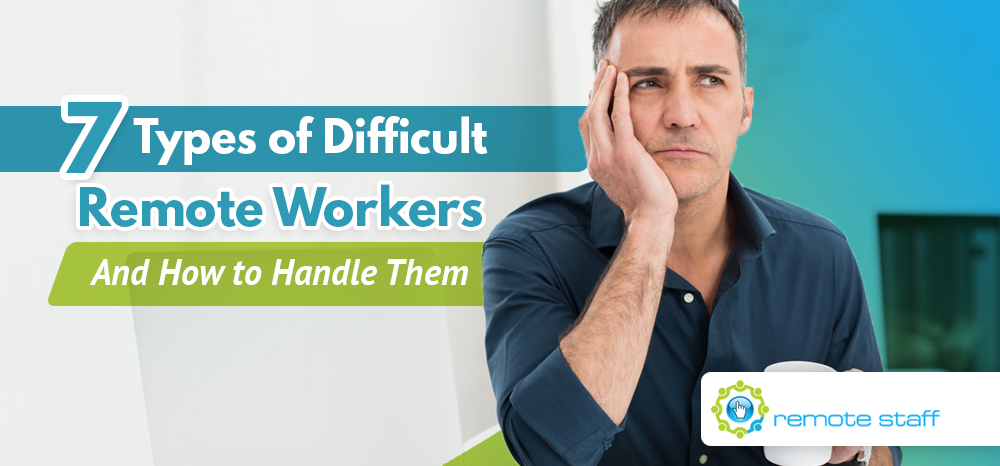Apart from the distance involved and the wider talent pool, hiring remote workers isn’t that different from hiring conventionally. You list the skills and specifications you need, shortlist candidates, and then pick one after a round of interviews.
And as with conventional employees, you’ll occasionally run into a few bad apples. Sometimes, you can sniff them out early on. However, some of them manage to do well enough on the interviews to get hired. Thus, it might take a while for you to realise that you’ve got a difficult remote worker on your hands.
Now, this is a serious matter as one bad employee can affect the others, even if they’re all working from different countries or continents. ‘Tis all part of being human, I’m afraid. If excellence is contagious, so too is mediocrity.
It’s harder to tell how an employee actually performs and interacts when you’re not in the same space. On the other hand, there are some clues you can look out for. Basically, most difficult remote employees fall under the following archetypes. Here’s how to spot and, most importantly, how to deal with them:
1. The Slacker.

Also known as “the lazy one.” Now, this is a great anomaly among remote workers since you have to be particularly resourceful and industrious to excel in this field. But, well, some slip through the cracks somehow.
The Slacker tends to disappear when deadlines loom large, and his/her team members end up picking up the slack. Ugh.
There are several approaches to this one. First, you can lay out frequent, periodic milestones for them -and consequences if they fail to meet these. Think regular deadlines for turning in output. Second, productivity tracking tools and occasional video check-ins ought to keep them on their toes.
2. The Perpetual Victim.

“My computer broke last night.” “The internet/power was out.” “I ran out of coffee.” “My cat died.” Sound familiar?
You see, the perpetual victim never runs out of excuses as to why they were unable to do their work. There’s ALWAYS something happening to them.
Of course, things like that happen in real life. (Maybe s/he was especially attached to his/her cat. I dunno.) Unfortunately, such excuses can be hard to verify if your staff works remotely and frequent occurrences can be suspicious.
As with the Slacker, monitoring software and video check-ins help. Furthermore, you should also make your expectations specific and crystal clear. Reiterate what their daily tasks, deadlines, and expected output are, and keep following up as needed.
With Remote Staff, we go one step further for our clients. If you’re feeling particularly suspicious, you can get one of our people to personally check in on your worker. (Btw, the link to sign up with us is at the bottom of this article. *wink*wink*)
3. The Hothead.

It’s normal to get angry and frustrated at work from time to time. Constantly screaming at your colleagues during video calls and picking fights isn’t. The latter is typical Hothead behaviour.
What makes the Hothead dangerous is that he can drive your best remote workers away. No one enjoys working alongside a human volcano that’s just waiting to erupt.
Nip this worker’s disruptive behaviour in the bud by telling them that you won’t tolerate it. Follow through by removing them when they persist – no matter how talented they might be. You need to make an example of them as well as protect your other workers.
4. The Poor Communicator.

Ah, and now, we have the close relative of the Slacker. Whether by accident or by design, this person is nearly impossible to get in touch with. That’s a no-no in remote work, where constant and clear communication is critical to getting things done.
The inability to respond or reach out can have dire consequences for you and your team. This could lead to missed deadlines, a drop in productivity, or botched projects.
Okay, so it’s possible that this worker might have a preferred method of communication. Maybe they’re shy about taking video or audio calls and are more comfortable chatting. Once you figure that out, require them to be available at certain times on the preferred communication platform. You may also arrange for consequences if they aren’t.
5. The Know-It-All.

This person thinks s/he knows how to solve any problem and that his/her ideas are better than everyone else’s. And they can be pretty obnoxious about letting their colleagues know.
It would be best for you to gently take this person aside to address the problem. Kindly explain that they need to let other people speak up and that their colleagues’ ideas also have merit. Afterwards, be sure to mediate virtual meetings so that others can get a word in without this person talking over them.
6. The Drama King/Queen.

Everything is about them. They take every little thing personally and are expert at throwing hissy fits at the slightest pretext.
Such dramatic displays get old quickly and can be rather draining for everyone around. Thus, you may need to employ an approach that’s similar to the one for the Hothead. Reiterate that you expect professionalism in the virtual workplace, and implement consequences if they don’t exhibit such. (e.g., Don’t hesitate to boot them off a call if they indulge in uncalled-for histrionics.)
7. The Naysayer.

Obviously, you don’t want yes-men or women on your team. A little dissent can be healthy for innovation, and having a remote worker who isn’t afraid to speak up when something is wrong can be an asset.
The trouble with The Naysayer, on the other hand, is that they oppose change in all its forms. You can spot one among those who are quick to slap down suggestions for new policies and processes, even when they have clear benefits.
Whatever you do, don’t put this person in a leadership position. It’s fine for them to play Devil’s Advocate from time to time, but rein them in when you have to so they don’t poison the well.
Don’t get me wrong. There are a lot of amazing remote workers out there, and I find that the difficult ones are the exception rather than the rule. The Philippines is full of many hardworking, loyal, and dedicated remote workers. With a bit of guidance, you can easily build your dream team from among them.
With Remote Staff, you’ll even be assigned an officer dedicated to smoothing over any misunderstandings or concerns. We also have our own productivity tracking tools that have helped thousands of customers monitor their staff for years. Sign up today and experience their benefits for yourself.
Serena has been working remotely and writing content for the better part of the last decade. To date, she's written for Pepper.ph and Mabuhay Magazine, among others, and has churned out more than a thousand articles on everything from The Basics of Stock Market Investing to How to Make Milk Tea-Flavored Taho at home. Hermits, aspiring hermits, and non-hermits with interesting project propositions may email her at serena.estrella10@gmail.com.
























 Zero Recruitment Fee
Zero Recruitment Fee